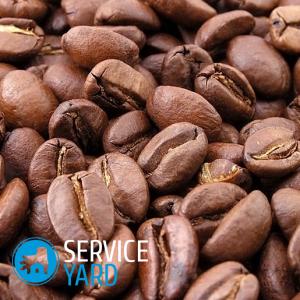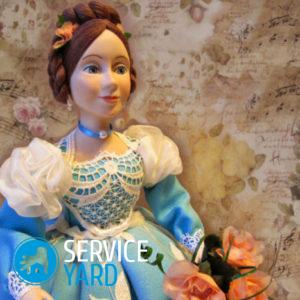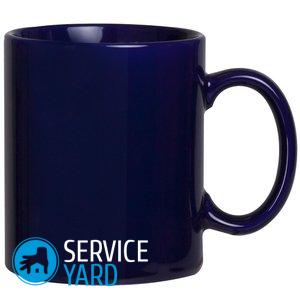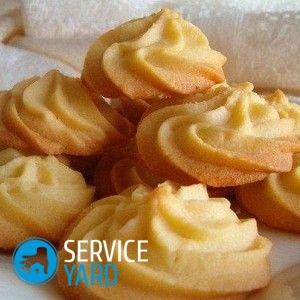Copper samovar
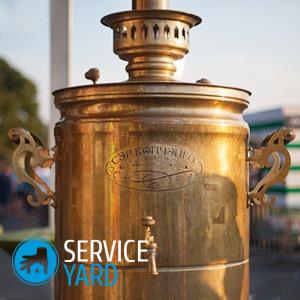
- What are samovars?
- Where to begin?
- How to clean a copper samovar at home?
- How to clean a copper samovar from scale?
- We clean the samovar outside
- How to clean a brass samovar at home?
- Gilded samovar
- Stainless steel samovar
- Aluminum Samovar
- How to clean a nickel-plated samovar from the outside?
- That the samovar served for a long time
- Stock footage
A real old samovar gives tea party a special charm. It is stylish, it is fashionable. True tea connoisseurs are ready to give huge sums of money to make such a miracle decorate their table. Ancient samovars fall into modern apartments in many ways - from grandmother's attics, antique shops, and even from garbage cans. Of course, a copper samovar, like its gilded or aluminum counterpart, must be put in order. How to clean a brass samovar from the outside? About how to care for such dishes from this and other materials, you will learn by reading the article.
to contents ↑What are samovars?
It just seems that they are all made of the same material, but in fact the samovars are all different. Therefore, before you clean an old samovar at home, try to determine what it is made of. It could be an item:
- copper;
- brass;
- gilded;
- aluminum;
- nickel plated;
- from stainless steel.
How to distinguish between them? - Not so difficult:
- in color and gloss;
- according to the description, if you bought an item in an antique store;
- according to your passport, if you have a modern electrical appliance bought in an electrical goods store.
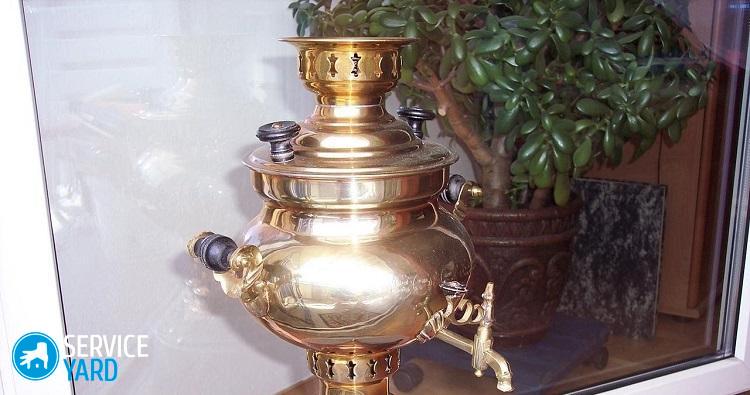
All materials of which samovars are made differ in color:
- If the surface is reddish, the item is made of copper.
- Brass items are yellow.
- The stainless steel has a grayish-silver shade and shines.
- Aluminum - gray and dull.
- The gilded teapot is yellow, but not as bright as brass.
- As for nickel-plated products - they look like stainless steel items, and they clean them almost the same way. In addition, nickel-plated samovars are usually electric; they began to be made relatively recently.
to contents ↑Important! Most often, copper and brass samovars are found - once they were the most popular. In the merchants' and bourgeois, and even in peasant houses, one could see precisely them. Gilded samovars were most often made to order, they were very expensive, so now there are perhaps only collectors. Aluminum is also rarely found, but for another reason - this material is extremely soft and not particularly beautiful, so utensils for a tea ceremony from it were not appreciated.
Where to begin?
It’s better to start any work with preparation, then the process itself will go much faster. You have already decided on the material. Now prepare detergents and other items that no cleaning service can do without. You probably have everything you need or what you need, you will find in the most ordinary shops and pharmacies.
You will need:
- descaling agent;
- coarse salt;
- soda ash;
- baking soda;
- flour;
- ammonia;
- 9% vinegar;
- lemon acid;
- dentifrice;
- brush;
- a piece of flannel;
- a piece of linen or cotton fabric;
- paper towels or newspaper;
- sponge;
- rubber glove.
Important! So that all your efforts to clean the samovar are not wasted and you brew a really high-quality and tasty drink in the future, read about the best varieties of tea.
It is more convenient to first clean the inside - remove the scum, which can be a lot, and then kick the samovar outside.In ancient times, when people did not know special means for washing dishes and abrasive pastes, samovars were cleaned with river sand and grated brick. It took a lot of time, any plaque disappeared, but scratches appeared on the surface of the samovar. Now there is an opportunity to do without such extreme ways. It is better to refuse abrasive pastes if possible - in any case, when washing the outer part of the samovar.
Important! All removable parts of the samovar must be removed and washed separately before washing. This is a faucet, stand, crown and handles.
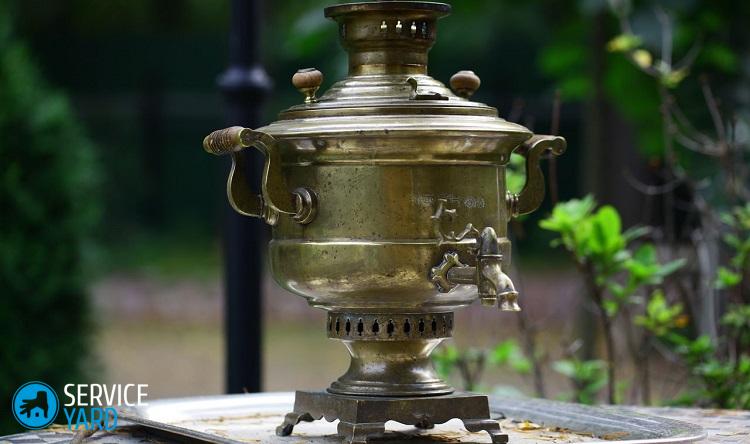
How to clean a copper samovar at home?
With a copper samovar, you can simultaneously clean both the outer and inner parts, as well as removable parts. For this you need:
- tank in which you can completely place the samovar:
- soda ash;
- water.
Important! Tea will be even tastier, and time for a tea party with relatives is more pleasant if you have beautiful and suitable dishes. Remember that coziness and a pleasant home environment consists precisely in attention to family and useful trifles.
Take advantage of our workshops:
The tank is better to take enameled or stainless steel, and act like this:
- Fill the tank with water.
- Dissolve soda ash at the rate of 2 tablespoons per 1 liter of water.
- Bring the water to a boil.
- Dip the samovar and all removable parts into the solution.
- Boil the product for about 30 minutes.
- Wait for the water to cool slightly.
- Remove all elements and wipe it with a flannel.
Thus, you immediately bring shine on the outside and get rid of the inner scale.
Important! If there is no such tank and you clean the samovar in another way, small parts can be boiled in a solution of soda ash in a small saucepan.
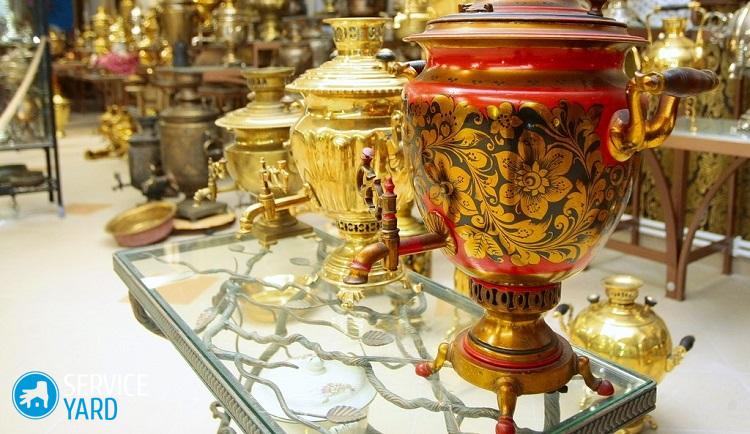
How to clean a copper samovar from scale?
Descaling methods are the same for all samovars. The easiest way to descale your samovar is to buy a special plaque remover at a hardware store.
Important! But you need to carefully look at the labels, because the descaling agents from washing or dishwashers are very different in composition from those intended for dummies and other utensils. You need a remedy for dummies.
Option 1
On sale, you may find scale removers that you need to add when boiling, or those with which you can simply wash the samovar. If boiling is not necessary, then proceed in the following order to clean the samovar inside from scale:
- Apply the product on the inside of the samovar with a sponge.
- Wait as long as indicated in the instructions.
- Rinse off and thoroughly rinse all surfaces.
Important! When you finish cleaning the samovar, you can spend time creating a few more pleasant things for a traditional tea party. If you do needlework, you will probably be able to make an original doll on the teapot in our workshops.
Option 2
If the product is added by boiling, strictly follow the instructions, especially when it comes to concentration.
Important! An insufficient amount of the product will make cleaning less effective, and an excess will not bring any benefit to the material of which the samovar is made.
Standard application instruction:
- Fill the samovar with water.
- Add the descaling agent according to the proportion.
- Bring the water to a boil.
- Boil water for about 30 minutes.
- Pour out water, rinse the samovar thoroughly and wipe its inside with a soft cloth.
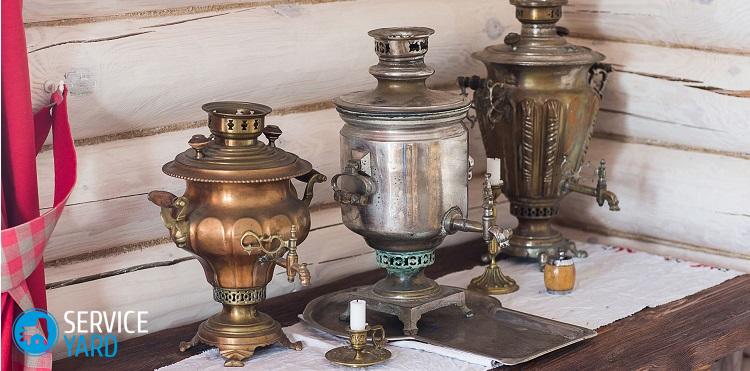
Small scale deposits
To answer the question of how to remove a samovar from scale at home, potato peelings, raw potatoes, ammonia, vinegar or citric acid will help.
Option 1
If the plaque is small, you can try to remove it using ordinary raw potatoes:
- Rub the potato inside of the item.
- Wait half an hour.
- Remove residues.
Important! Potatoes can be grated and cooked gruel, apply it to the walls and leave overnight.
Option 2:
- Dissolve a package of citric acid (30 g) in a glass of water.
- Dampen a cloth in the solution.
- Apply the solution to the places where scum has formed.
- Wait half an hour.
- Rinse off the acid, wash the samovar and wipe with a flannel.
Option 3
If there is little scale, it will be perfectly wiped off with a cloth or cotton pad dipped in 9% vinegar solution. But when there is a lot of scale, it is better to do so:
- Fill the samovar with hot water.
- Add vinegar to the water at the rate of 1 cup per 1 liter of water.
- Leave the samovar for 8-10 hours (for example, at night).
- Wash the samovar well.
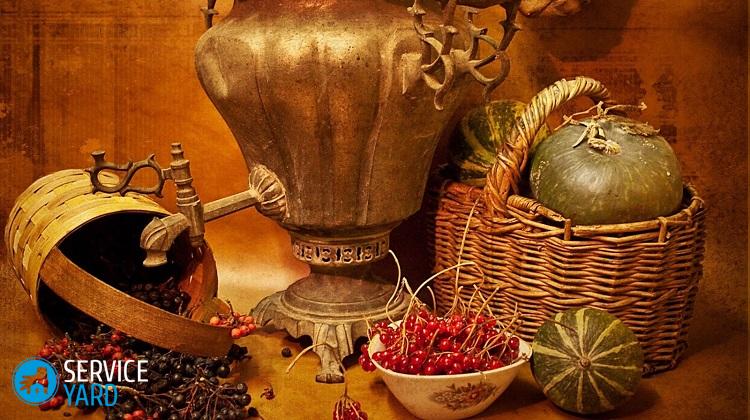
Old scale
For this traditional way, you need a lot of potato peeling - so much so that you can fill half of the samovar:
- Rinse well with running water.
- Fill the inside of the dishes to half.
- Pour boiling water over cleaning.
- Wait for the water to cool.
- Repeat the process a couple more times - the cleaning must be changed every time.
- Discard the last batch of cleanings.
- Rub the walls inside with soda.
- Rinse.
- Boil water in a samovar, drain it.
After that, you can boil tea in a samovar.
Soda will help you out
Sweet soda, like Fanta, Coca-Cola, is perfectly dealt with scum:
- Pour soda into the samovar.
- Bring to a boil.
- Boil for half an hour.
- Drain soda.
- Remove the remaining scale with a brush.
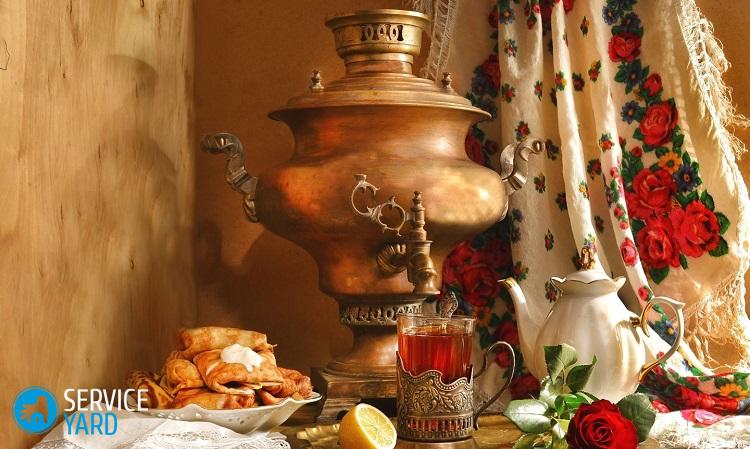
We clean the samovar outside
After understanding the scum, clean the outside. For each material of which the samovar is made, there are their own compositions - and their limitations. You can easily make a copper, brass or steel samovar shine, but look for the answer to the question of how to clean a samovar to shine, if you have aluminum in front of you, you can not even try, the samovar will remain dull.
Option 1
In order to clean the copper samovar from the outside, you need:
- coarse salt:
- flour;
- 9% vinegar;
- sponge;
- flannel;
- newspaper or paper towels.
This cleaning method is both mechanical and chemical. You wipe the plaque by hand, but salt, flour and vinegar greatly facilitate your work:
- Combine coarse salt, flour and vinegar to make a fairly thick, uniform paste.
- Spread the samovar on the paste.
- Apply the paste on the outside of the samovar.
- Polish the samovar with a piece of flannel or a paper towel.
Option 2
Citric acid perfectly cleanses nasty gray-green deposits:
- Prepare a composition of citric acid and water - 1 pack of citric acid in a glass of water.
- Apply the composition to the outside of the samovar.
- Polish the samovar.
Instead of citric acid, freshly squeezed lemon juice can be used.
Important! If you are dealing with a copper samovar, try to distinguish a greenish patina from a gray-green plaque. Patina gives any copper product an elegant look and affects its value, but plaque indicates that the product was simply not looked after.
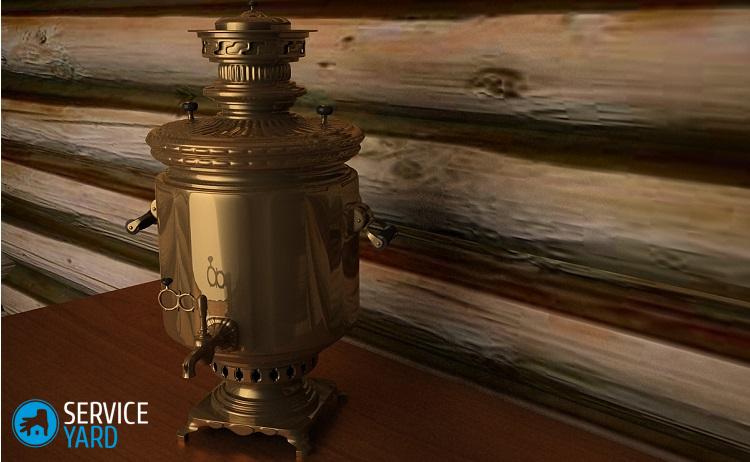
We clean small details
To clean small parts, unless you boil them with soda ash, you can use ordinary baking soda:
- Make a solution in the ratio of 1 tbsp. l soda per 1 liter of water.
- Soak small items.
- Wait half an hour.
- Rinse the crown, stand, handles and faucet in running water.
- Wipe them with a flannel.
How to clean a brass samovar at home?
Brass is an alloy of copper and zinc. Zinc does not like organic acids, so vinegar and lemon juice should not be used. Of organic acids, oxalic is suitable, and if it is not, ammonia will always help you out.
Option 1:
- Dip a piece of flannel in liquid ammonia.
- Wipe the samovar outside.
- Ventilate the product (no need to wash).
Important! You do not need to press hard when you rub the walls.
Option 2
Liquid ammonia can also be part of the brass cleaning solution. To prepare the cleaning paste you need:
- 30 g of ammonia;
- ½ cup of water;
- 2 tbsp. ltooth powder.
Mix the components to make a homogeneous mass. Put the paste on the sponge and polish your samovar.
Important! Instead of powder, toothpaste is also suitable if there are no dyes in it. This composition is suitable for processing the inside of a samovar.
Option 3
Oxalic acid cleans brass items well:
- Prepare a solution at the rate of 1 cup of acid per 10 liters of water.
- Apply the mixture on the outside, wait five to ten minutes, then rinse with cold water.
- After this, the surface, without wiping, you need to rub with soda, then rinse and wipe the samovar.
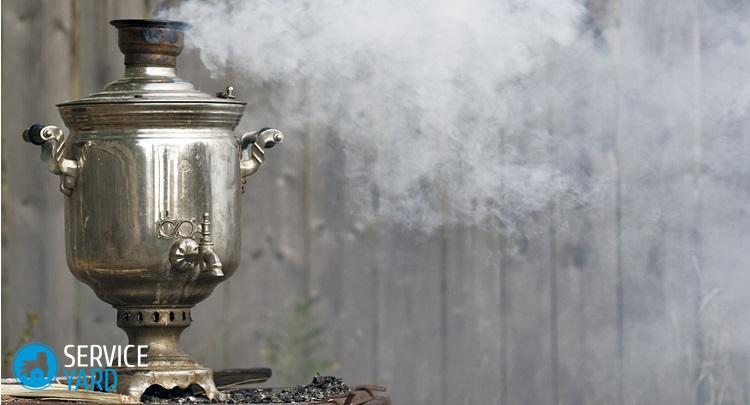
Gilded samovar
On such samovars, plaque rarely forms, but sometimes they still have to be cleaned. Abrasive pastes are not suitable for this, and most of the substances that are in your cabinets, too. You need:
- 1 raw egg;
- sodium hypochloride 8%.
What to do with all this:
- Separate the protein from the yolk - you do not need the yolk.
- Mix 1 protein with 1 tbsp. l sodium hypochloride.
- Clean the gilding solution - after a few minutes of processing, the samovar will sparkle as good as new.
Stainless steel samovar
How to clean a samovar from a stainless steel outside? - Vinegar, and only vinegar:
- Moisten a cloth or cotton pad in a 9% vinegar solution.
- Wipe the entire surface of the samovar, even those places that seem clean.
- Polish the walls with a piece of cloth or paper.
Aluminum Samovar
Such samovars come across relatively rarely, but it is still better to know in advance how to clean it. You need:
- ammonia;
- borax;
- water.
Mix the ingredients in a ratio of 1 tsp. Of ammonia, 3 tsp. Of borax to 2 cups of water.
Wipe the walls of the product completely with this product - internal and external.
Important! What is tea without sweets? You can buy them at a nearby store, but it will be healthier and tastier if done on your own, especially if you like to cook. Here our recipes for all occasions will help you:
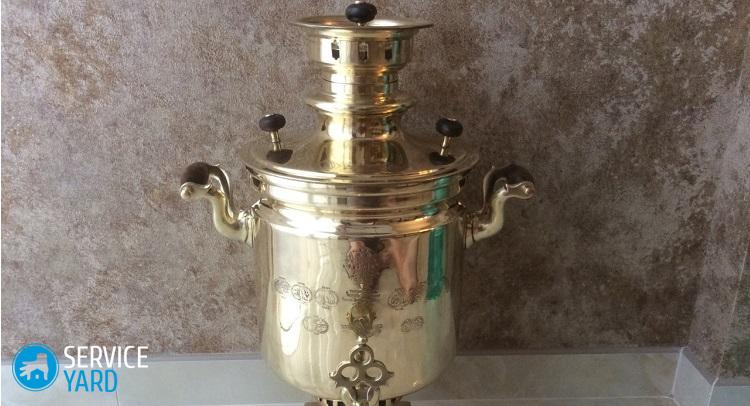
How to clean a nickel-plated samovar from the outside?
Nickel is perfectly cleaned, beautifully shiny, and any plaque from it is cleaned in two counts. Modern models, including electric ones, most often nickel.
Option 1
Prepare a solution that includes:
- 5 ml of ammonia;
- 15 g borax;
- 0.5 l of water.
Wipe all parts of the product with a solution, and then simply wipe it with a soft cloth.
Option 2
For cleaning nickel surfaces, toothpaste and ammonia paste are also suitable.
- 100 ml of water;
- 60 ml of ammonia;
- 30 g of tooth powder.
Wipe the nickel-plated samovar with this solution - it will sparkle like new.
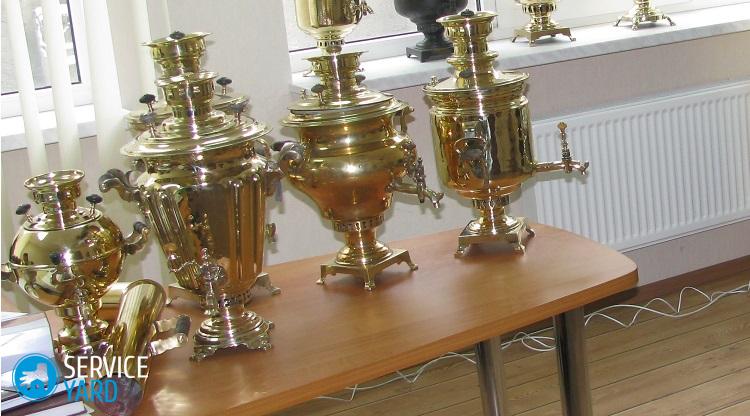
That the samovar served for a long time
Regardless of whether you have an antique item or a modern electric one, you most likely want it to serve as long as possible - and not just serve, but also decorate your kitchen.
This is easy to achieve if you follow simple guidelines.
- Try to use abrasives as little as possible to clean this item. Even coarse salt leaves scratches.
- Clean the dishes with a soft sponge and a cloth.
- If you are not sure what material the samovar is made of, try using a cleaning solution on the inside first and see if it reacts with the metal.
- The item needs to be washed after each tea party, especially if you often use it.
to contents ↑Important! A hot samovar should not stand without water. But if he stands in the winter in a very cold room - the water from it, on the contrary, must be drained.
Stock footage
Now you have the full amount of information on how to clean a copper and any other samovar - both inside and outside. Choose a method and means more convenient for you, and do not forget to timely care for such colorful dishes. Then you will be comfortable and guests will be surprised.




